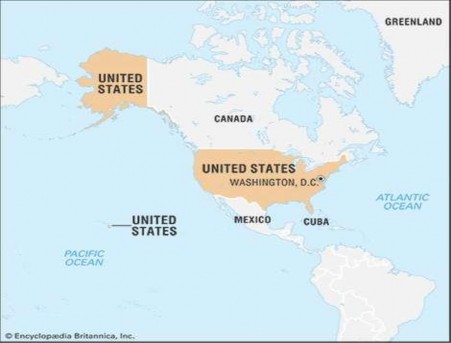1. The United States of America
United States of America, U.S.A., is a federal republic of 50 states. It is bounded on the north by Canada, on the east by the Atlantic Ocean, on the south by the Gulf of Mexico and Mexico, and on the west by the Pacific Ocean. The United States is the fourth largest country in the world in area (after Russia, Canada, and China). Its military capabilities, economic size, science and technology base and active involvement in international affairs provide it a unique status. The term ‘superpower’, as applied to the USA, is reflective of the role played by the US around the world in the last century.

1.1. India and the United States: Current Status“Enduring Global Partners in the 21st Century”.1.2. Background♤ For most of the period after India achieved independence in 1947, the U.S. viewed South Asia as a region largely peripheral to its strategic needs.♤ During the 1962 Sino-Indian war, the U.S. publicly supported India’s interpretation of its♤ India attached much significance to autonomy in international matters.♤ India’s “non-aligned” foreign policy thus became a source of considerable irritation to the♤ In essence, during the Cold War India refused to promote U.S. grand strategic goals and offered few economic benefits, while posing little direct military threat to American interests. India therefore was largely ignored.♤ New Delhi realized that a closer relationship with Washington could help them fill the♤ Since the end of Cold War and increasingly in the last decade common strategic interests such as managing the rise of China, ensuring maritime security and confronting international terrorism combined with shared values such as democracy have driven these relations.o allows India to reserve all its indigenous uranium for its weapons programme, and♤ The civil nuclear agreement has played an important role in:1.3.2. India-US Cooperation on Nuclear Energy: Historic Background1.4. The Mechanism of Cooperation♤ There are more than 50 bilateral dialogue mechanisms between the two governments.1.5. Political Ties♤ The frequency of high-level visits and exchanges between India and the U.S. has gone up significantly in recent years.♤ President Obama's visited India on 25-27 January 2015 as the Chief Guest at India's Republic Day.Session of the U.S. Congress, he was the sixth Indian Prime Minister to address the U.S. Congress.♤ The PM visited the United States to meet President Donald Trump in June 2017.♤ This has resulted in intensification in defence trade, joint exercises, personnel exchanges, collaboration and cooperation in maritime security and counter-piracy, and exchanges between each of the three services.♤ Aggregate worth of defence acquisition from U.S. has crossed over US$ 13 billion (MEA 2016).1.6.2. Way Forward: The Foundational Agreements♤ India had signed- the General Security Of Military Information Agreement (GSOMIA) in 2002.1.7. Counter-terrorism and Internal Security1.8. The Economy1.8.1. Trade♤ India-US bilateral trade in goods and services increased from $104 billion in 2014 to $114 billion in 2016.1.8.2. Investment and Development♤ There are several dialogue mechanisms to strengthen bilateral engagement on economic and trade issues, including a Ministerial level Economic and Financial Partnership.1.8.3. Major issues of Contention in Economyo Export Subsidies: In March 2018, USA filed a complaint at the WTO about India’s1.8.4. Major Issues: IPR1.9. Energy♤ India received its first crude oil cargo of 1.6 million barrels from the US at the Paradip Port, Odisha on 2 October 2017.♤ The U.S. Department of Energy has so far given its approval for export of LNG from seven liquefaction terminals in the U.S., to countries with which the U.S. does not have a free trade agreement (FTA).1.10. Climate ChangeChallenges in Climate Change Cooperation1.11. Education and Culture♤ About 130,000 Indian students are pursuing advanced degrees in the U.S.1.12. SpaceSpace Cooperation: A historical Background1.13. Science and Technology1.14. P2P: Diaspora1.15. Global Public Health♤ Under the 2010 U.S.-India Health Initiative, four working groups have been organized in the areas of Non-Communicable Diseases, Infectious Diseases, Strengthening Health Systems and Services, and Maternal and Child Health.1.16. Strategic Components of the Relationship1.17. The Pakistan Factor1.17.1. Recent Trends♤ Mr. Trump’s new policy, according to the official, is driven by the desire to have a successful strategy in Afghanistan. However, India’s primary concern has been regarding cross border state sponsored terrorism emanating from Pakistan.1.17.2. Pakistan Factor: What’s New?1.18. The China Factor1.19. The Indo-Pacific1.20. The Russia Factor♤ USA is the largest military supplier in the World. India one of the largest military buyers♤ Now Moscow seems to be pivoting towards Islamabad as New Delhi becomes closer to Washington.1.21. The Joint Declaration 2017suspected terrorists for travel screening, strengthening information exchange on plans, movements and linkages of terrorist groups and their leaders, terror financing, etc.♤ This reaffirms that India and USA are on the same page with respect to dealing with the rapidly growing influence and presence of China in the Indian Ocean and Indo-Pacific region.1.23. Policy Options
